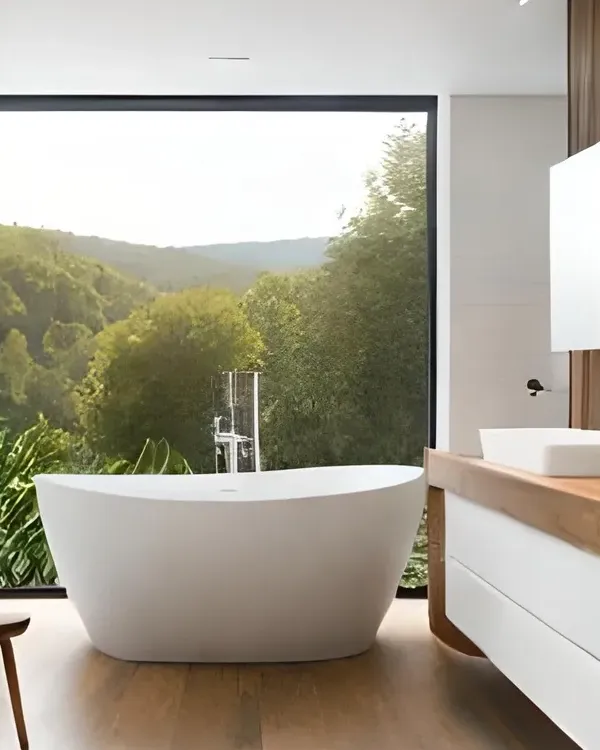Discover the art of bathroom design: from layout optimization to fixture selection, unlock the secrets to creating your dream bathroom space.
Introduction to Bathroom Design
When it comes to designing our living spaces, the bathroom often takes a backseat. However, understanding the importance of bathroom design is crucial in creating a functional and aesthetically pleasing space that enhances our daily routines.
The bathroom is not merely a utilitarian room but rather an oasis where we refresh and rejuvenate ourselves. It should be a sanctuary that combines practicality with beauty, allowing us to start and end our days on a high note.
Bathroom design is an art form that has evolved over time, reflecting cultural and technological changes. In ancient civilizations, such as the Greeks and Romans, bathrooms were communal spaces where people gathered for socializing while attending to their personal needs.
These communal baths were lavish in their design, adorned with intricate mosaics and grand architectural elements that showcased the wealth and opulence of the era. As society progressed through different periods of history, so did bathroom design.
The Renaissance period saw a shift towards more private bathing areas within individual homes. Bathrooms became spaces for personal hygiene rather than social gatherings.
However, they still exuded elegance through ornate detailing and luxurious materials. The 20th century brought significant advancements in plumbing technology, which revolutionized bathroom design.
Indoor plumbing became commonplace, allowing for the separation of bathrooms from other living spaces within homes. This newfound privacy gave rise to modern approaches to bathroom design focused on functionality and efficiency.
The Intersection of Functionality and Aesthetics
In today’s world, bathroom design goes beyond mere functionality; it incorporates aesthetics as well. A well-designed bathroom seamlessly blends practicality with beauty to create an immersive experience for its users.
A poorly designed bathroom can hinder our daily routines by making tasks cumbersome or uncomfortable. For example, inadequate storage space can lead to cluttered countertops, while a poorly positioned toilet may impede movement within the room.
On the other hand, a thoughtfully designed bathroom streamlines our activities by maximizing efficiency and providing easy access to essential items. However, functionality alone is not enough.
The visual appeal of a bathroom is equally important. Aesthetics play a crucial role in creating an environment that promotes relaxation and well-being.
Colors, textures, lighting, and materials all contribute to the overall mood and ambiance of the space. A beautifully designed bathroom can evoke feelings of serenity and luxury, making it a retreat from the outside world.
The Evolution of Bathroom Design
Over time, bathroom design has undergone remarkable transformations influenced by cultural shifts and technological advancements. Cultural changes have shaped our perceptions of hygiene and privacy, driving the evolution of bathroom design.
As societies became more aware of sanitation practices in the 19th century, bathrooms began to incorporate features like bathtubs for soaking or showers for quick cleansing. This shift represented a departure from earlier communal bathing practices and emphasized personal hygiene as an essential aspect of individual well-being.
Technological developments have also played a significant role in shaping modern bathroom design. Innovations such as efficient plumbing systems, water-saving fixtures, heated flooring, touchless faucets, smart mirrors with integrated technologies – all have revolutionized how we interact with our bathrooms on a daily basis.
Understanding the importance of bathroom design is key to creating spaces that strike a balance between functionality and aesthetics. As we continue to progress through time with evolving cultural values and technological advancements at our disposal, it is fascinating to see how these factors will continue influencing future trends in bathroom design.
Layout and Space Planning: Creating a Functional and Harmonious Bathroom Space
When it comes to bathroom design, layout and space planning play a paramount role in creating a functional and harmonious space. The choice of the bathroom layout depends on factors such as the size of the room, its purpose, and the needs of its users.
There are various types of bathroom layouts to consider, including single-user bathrooms, family bathrooms, and en-suite bathrooms. In a single-user bathroom, the focus is on optimizing space for one individual’s needs.
This layout typically includes essential fixtures like a toilet, sink, and shower or bathtub. The arrangement should allow for ease of movement while ensuring sufficient privacy.
Family bathrooms require careful consideration to accommodate multiple users efficiently. Aside from the basic fixtures, additional features such as double sinks or separate shower stalls might be necessary.
Traffic flow becomes essential in this case since several individuals may need access to different areas simultaneously. En-suite bathrooms are connected directly to a bedroom, offering convenience and privacy to its occupant(s).
Here, space planning should emphasize seamless integration with the master bedroom while ensuring all essential fixtures are present. To optimize space utilization in any bathroom layout, it is crucial to consider traffic flow patterns.
Placing fixtures strategically can help minimize congestion points. Additionally, incorporating smart storage solutions such as built-in cabinets or shelving above toilets can maximize available space while keeping essentials organized.
Fixtures and Fittings: Functionality Meets Aesthetics
A well-designed bathroom is not complete without carefully selected fixtures that balance functionality with aesthetic appeal. When considering fixtures for your bathroom design project, it is important to review various options available in terms of toilets, sinks, showers/bathtubs. Toilets come in different types such as close-coupled toilets (where the cistern sits directly on top of the bowl), wall-hung toilets (suspended from the wall to create a more spacious ambiance), and back-to-wall toilets (where the cistern is hidden behind a wall).
Materials like porcelain, ceramic, and acrylic are commonly used for fixtures. Porcelain offers durability and an elegant appearance, while ceramic provides versatility in terms of design options.
Acrylic fixtures are lightweight and easy to maintain. Sinks are available in diverse styles, including pedestal sinks (supported by a freestanding column), vanity sinks (incorporating storage cabinets beneath the sink), and vessel sinks (sitting atop the counter).
Different materials like glass, porcelain, or stone can be used for sinks. Glass sinks add a touch of modernity and elegance, while porcelain or stone provide durability combined with timeless appeal.
Showers and bathtubs also offer numerous design choices. Showers range from walk-in showers with frameless glass doors to enclosed shower cabins with integrated steam functions.
Bathtubs come in traditional clawfoot or freestanding options as well as contemporary built-in tubs with sleek lines. The choice depends on personal preferences and available space.
Lighting Design: Illuminating Your Bathroom Oasis
Proper lighting design is essential for creating an inviting bathroom ambiance that balances functionality with aesthetics. Adequate lighting contributes to tasks like grooming while setting the desired mood for relaxation. To achieve optimal lighting balance, it is important to consider different types of lighting fixtures suitable for bathrooms.
Recessed lights provide uniform illumination throughout the space without compromising visual comfort. These fixtures can be strategically placed above showers or bathtubs, on either side of mirrors, or along the perimeter of the ceiling.
Vanity lights play a crucial role in ensuring proper illumination for grooming tasks such as applying makeup or shaving. Placing them on either side of the mirror eliminates shadows on the face.
Ambient lighting sets the overall mood in your bathroom. Incorporating dimmer switches allows you to adjust the level of illumination according to your preferences.
When considering lighting design, privacy needs should also be taken into account. Frosted glass or shades can be used on windows or around shower areas, allowing natural light while maintaining privacy.
Bathroom design is a meticulous art that requires careful consideration of layout and space planning, fixtures and fittings, as well as lighting design. By understanding the different types of bathroom layouts and optimizing space utilization, one can create functional spaces suitable for different purposes.
Selecting fixtures that blend functionality with aesthetic appeal adds character to the bathroom. Well-thought-out lighting design ensures optimal brightness for various tasks while creating a soothing ambiance for relaxation.
Traditional Bathroom Designs
Sublime Elegance: Ornate Details and Classic Color Schemes In the realm of bathroom design, traditional styles have stood the test of time, exuding an air of refined elegance and sophistication.
Traditional bathrooms are characterized by their attention to detail, incorporating ornate elements that harken back to bygone eras. Ornamental flourishes such as crown molding, corbels, and intricate tile patterns bring a sense of grandeur to these spaces.
When it comes to color schemes in traditional bathrooms, classic palettes prevail. Shades of cream, soft pastels, and rich earthy tones provide a harmonious backdrop for the grandeur that permeates the space.
Muted hues like antique white or pale blue create a serene atmosphere while allowing exquisite details to take center stage. One hallmark of traditional bathroom design is the use of vintage-inspired fixtures.
Clawfoot bathtubs with ornate feet lend an old-world charm, while pedestal sinks evoke a sense of timeless beauty. Faucets and hardware with intricate designs in polished brass or oil-rubbed bronze complete the look with understated opulence.
To fully embrace tradition within this aesthetic realm, accessories play a vital role. Delicate chandeliers suspended from above cast warm light on marbled countertops adorned with gilded trays holding fragrant soaps and lotions.
Luxurious drapes swathed over windows add an extra touch of refinement while ensuring privacy. Traditional bathroom design offers a timeless retreat where indulgence meets sophistication—a sanctuary where intricacy harmonizes with tranquility.
Conclusion
Throughout history, bathroom design has evolved into an art form that combines functionality with aesthetics. From ancient communal bathhouses to modern private sanctuaries, our understanding of what makes for an exceptional bathroom has expanded exponentially. Today’s bathrooms reflect our desire for both practicality and beauty.
Whether one chooses a sleek and minimalistic approach or embraces the grandeur of traditional design, there is a myriad of options to suit every taste and preference. In our quest for the perfect bathroom, we are guided by our creativity, ingenuity, and an appreciation for the materials and concepts that shape these spaces.
As we embark on the journey of designing or remodeling our bathrooms, let us be inspired by the possibilities that lie before us. May your bathroom become not just a functional space but also a haven where you can immerse yourself in comfort and rejuvenation—a testament to your unique vision and style.


